Aeronautical telephone towers, the next step 5G
5G ground networks will support high-altitude balloons and drones, and one day they will be able to team up with them.
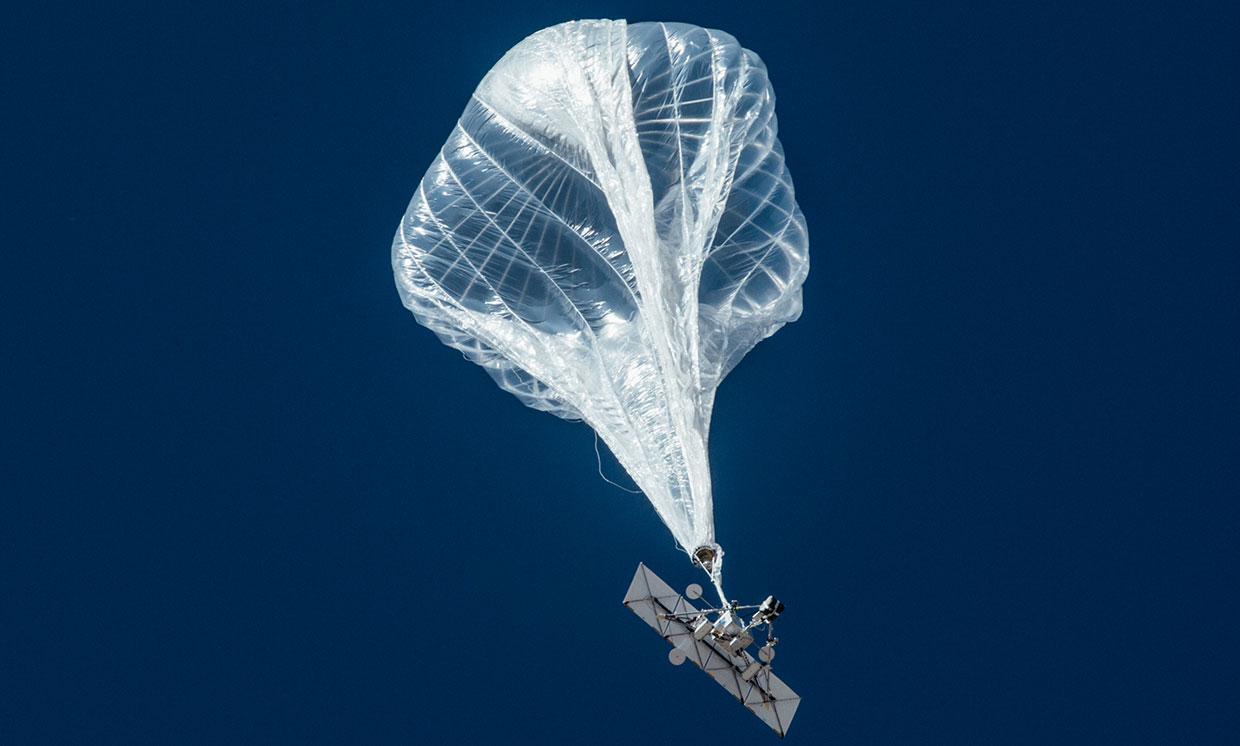
Photo: Loon
As the world seeks to introduce 5G high-speed mobile networks on earth, some companies continue to focus on floating cell towers in the sky. During the final session of the sixth annual 5G Summit in Brooklyn on Thursday (April 25), Silicon Valley IT and telecommunications industry leaders discussed whether drones and balloons could finally begin to provide commercial mobile communications and Internet services from the air.
On the same day, Loon, a subsidiary of Alphabet Inc., was originally a division of the balloon research company Google X, which announced a strategic partnership with Softbank HAPSMobile to use solar-powered balloons and drones to expand mobile Internet coverage. and assisting in the implementation of 5G networks.
No one expects Loon high-flying balloons and HAPSMobile drones to compete directly with 5G terrestrial networks in the near future. Until recently, it was not easy to develop a balloon or an unmanned platform / platform that was economical enough even for use in telecommunications, said Salvatore Candido, Alphabet's chief engineer and CTO at Loon. However, such high-flying platforms can help fill gaps when there is no coverage in rural or other underserved communities. Even rural areas of the United States may not meet current 5G plans.
A fleet of balloons and drones can also provide coverage on a temporary basis, for example, during major pre-planned events, such as the Super Bowl, or after natural disasters. Nokia previously partnered with Alphabet's Loon when it deployed its pilot balloon fleet to provide basic Internet services to 200,000 people in Puerto Rico after the island was destroyed in 2017 by Hurricane Maria, which hit the United States of America. . Nokia's LTE technology was installed on balloons as part of the broader coalition of AT&T and T-Mobile.
Loon has not yet begun implementing 5G equipment on its balloons, although a partnership with HAPSMobile Softbank suggests that someday it will be possible. However, the advent of 5G terrestrial networks can also make it easier for companies to deploy unmanned aerial vehicles or Internet balls. Nokia's Ziegler noted that 5G offers advantages over 4G LTE when implementing a relay / relay system that reflects a signal between groups of balloons or drones to expand the coverage area far beyond the ground station where the signal is coming from.
According to Giuseppe Loino, associate professor of electrical and computer engineering at the University of New York and director of Agile Robotics and Perception Lab, the presence of 5G network technology in terms of air traffic control can facilitate the tracking and control of a large group of unmanned aerial vehicles.
When the time comes, it will be important for telecom companies to create demand for high-speed mobile phones and Internet services by demonstrating what they can do for the public or customers, said Dallas Brooks, director of the Raspet Flight Research Laboratory at the University of Mississippi and Assistant Director of the ASSURE FAA Center of Excellence UAS. He invited the participants of the 5G Brooklyn Summit to collaborate with him and other universities participating in the research and testing program of the Federal Aviation Administration for the integration of drones in the US national airspace.
Loon may be one of the first to apply the solution with balloons, even if at the beginning they will not provide 5G services. The company's stratospheric balloons have already won their first commercial contract with Telkom Kenya to provide mobile services for nearly 50 million Kenyans. But Loon will certainly not be alone in trying to get such projects to work in the 5G era. “There is no shortage of people trying to create pseudo-satellites in the stratosphere,” Candido said.
Communication with balloons flying in the stratosphere at an altitude of 20 km creates a number of unique engineering difficulties. To expand network connectivity in unreached and underserved areas around the world, Loon combines advances in materials science, atmosphere modeling, machine learning, communications systems and more.
Loon took the most essential components of cell towers and redesigned them so that they were light and strong enough to be transported by balloon at an altitude of 20 km, at the edge of space. Loon balloons are designed and manufactured to withstand harsh conditions in the stratosphere, where the wind can blow more than 100 km / h and the temperature can drop to -90 ° C.

1. The balloon.
Each ball the size of a tennis court made of sheets of polyethylene is designed for more than 100 days of flight before landing on Earth in a controlled manner.
2. Flight equipment.
All flying equipment is highly energy efficient and runs on renewable energy sources. Solar panels provide power to the system during the day while charging the on-board battery, which allows you to work at night.
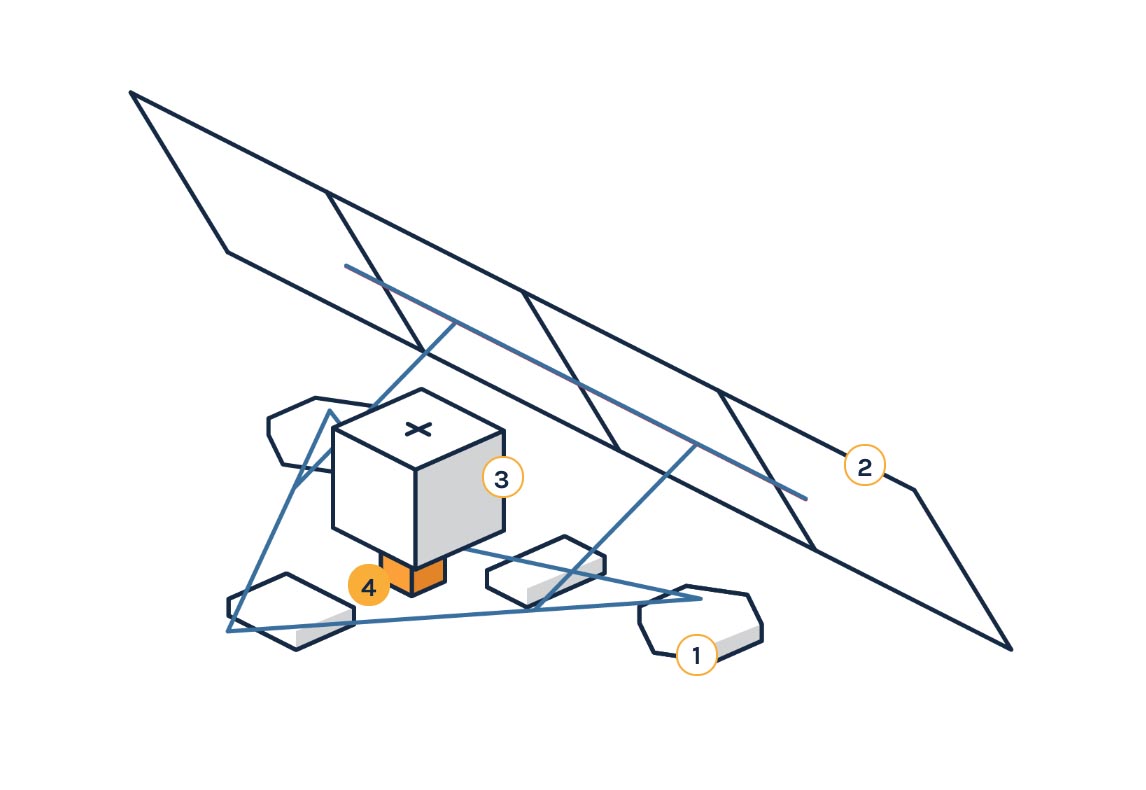
1. Antennas.
Antennas transmit data from ground stations, over a balloon network and back to the user's LTE phone. The user does not need anything but a standard LTE phone to connect to a Loon balloon.
2. Solar panels.
Solar panels provide power to the equipment during the day and charge the on-board battery for nighttime use.
3. Flight capsule.
The flight capsule contains electronics, a small set of communication devices that include transceivers. In electronics, a transceiver is essentially a transmitter and a receiver in a single package to control the Loon system.

4. The parachute.
After the flight, the parachute will automatically deploy to safely return the ball to Earth.
Custom-made, Autolaunchers systems are designed to safely and reliably scale Loon balloons. Side panels protect the balloon from the wind, as it is filled with lifting gas and set to run. The crane is directed downwind to smoothly release the Loon balloon into the stratosphere. Each tap is able to launch a new balloon every 30 minutes into the Loon network.
Stratospheric flight:
Loon balloons fly about 20 km above the Earth’s surface in the stratosphere, well above planes, wildlife and weather.
Autonomous navigation:
From launch pads, Loon balloons can reach any country around the world. Predictive wind models and autonomous decision-making algorithms move each balloon up or down into the layer of wind blowing in the right direction, delivering the balloon to where it should be directed. The navigation system operates autonomously using algorithms and software, while operators provide continuous human control.
Intelligent Networks:
The Loon Balloon Group creates a network that communicates with people in a specific area in the same way that a group of towers on the earth form a ground network. The difference is that the Loon towers are constantly moving with the wind. The software constantly learns to improve the "choreography" of balloons, which improves the quality of the network. The entire network can function autonomously, effectively distributing connections between balloons and ground stations, taking into account the movement of balloons, obstacles and weather events.
Loon's large coverage area allows mobile operators to expand their coverage area where necessary. Loon transmits an operator signal from the connection points on the earth, radiates it through several balloons in the stratosphere, and then sends it back to the user's LTE device. The entire network can function autonomously, effectively distributing connections between balloons and ground stations, taking into account the movement of balloons, obstacles and weather events.

1. The wireless Internet signal is transmitted via the Loon ground station to the nearest balloon from a mobile operator located on the ground.

2. The signal is transmitted through a network of balloons Loon ball.

3. Standard LTE user phones connect to the mobile network via Loon balloons.
Loon maintains constant telemetry and team communication with each balloon, tracking location using GPS. When the balloon is ready for decommissioning, the lift gas holding the balloon in the air ends, the parachute automatically unfolds to control landing. Descent is coordinated with the local air traffic control service to safely land the balloon in a sparsely populated area. Then, ground recovery teams collect equipment for reuse and recycling.

After recovery, balloons are laid out on a giant scanner in the Loon lab to check for microscopic holes and tears. This process paints a picture of how balloons react to conditions in the stratosphere. Performing this analysis allows you to draw the right conclusions when designing, which allows the team to develop balloons capable of flying for an increasingly long time.
From the first days of balloon testing, design and manufacture of special starter equipment, and to providing communications for people after natural disasters, Loon has committed itself to address the challenge of expanding Internet access for remote communities around the world.
The first tests were conducted back in 2011 using a meteorological balloon and base stations ready for the sale of radio frequencies - the first prototype. The next two years is a quick iteration process to prove that the Internet can work in a balloon.

Sometimes experiments did not go as planned. Here (below) a team of pioneering engineers are chasing an unsuccessfully launched ball in California's central rural valley. The balloon, which looked like a garbage bag, although it was pouted, was never left the ground.
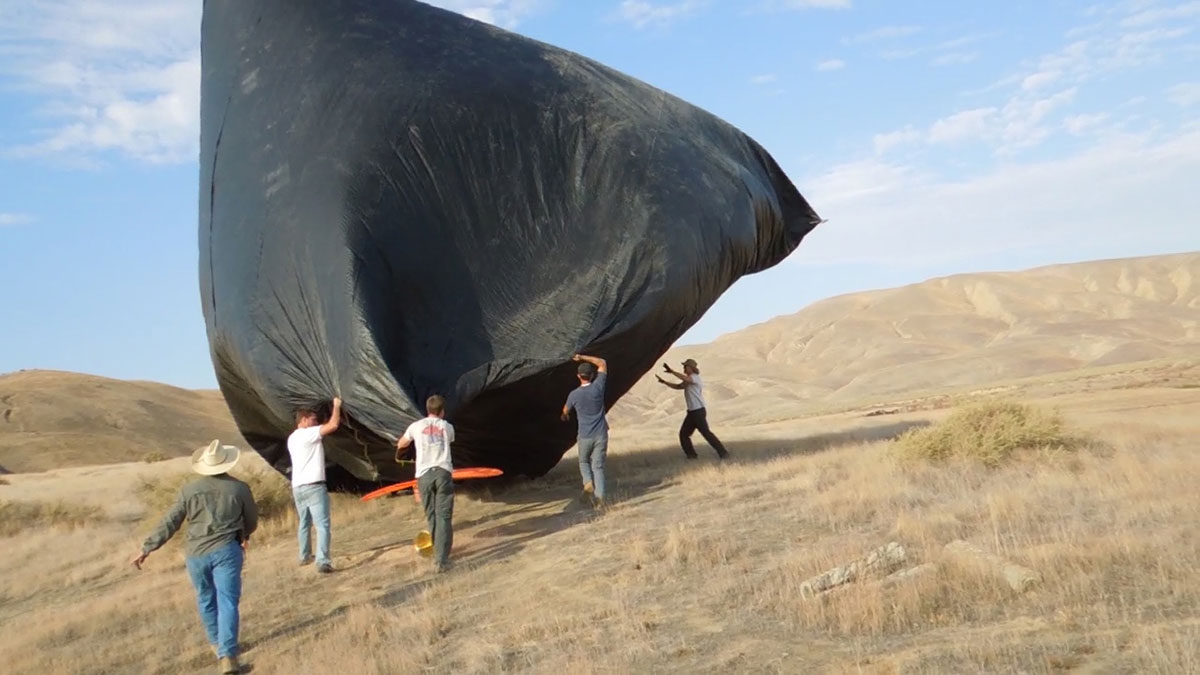
Before designing and building ultra-high pressure balloons capable of withstanding hundreds of days of flight, the team worked diligently to understand the laws of physics in the stratosphere. Using balloons with zero pressure, as shown in the figure (below), the team observed how the gas expanded and contracted at extreme temperatures and pressures in order to understand their effect on the ability of balloons to stay afloat.
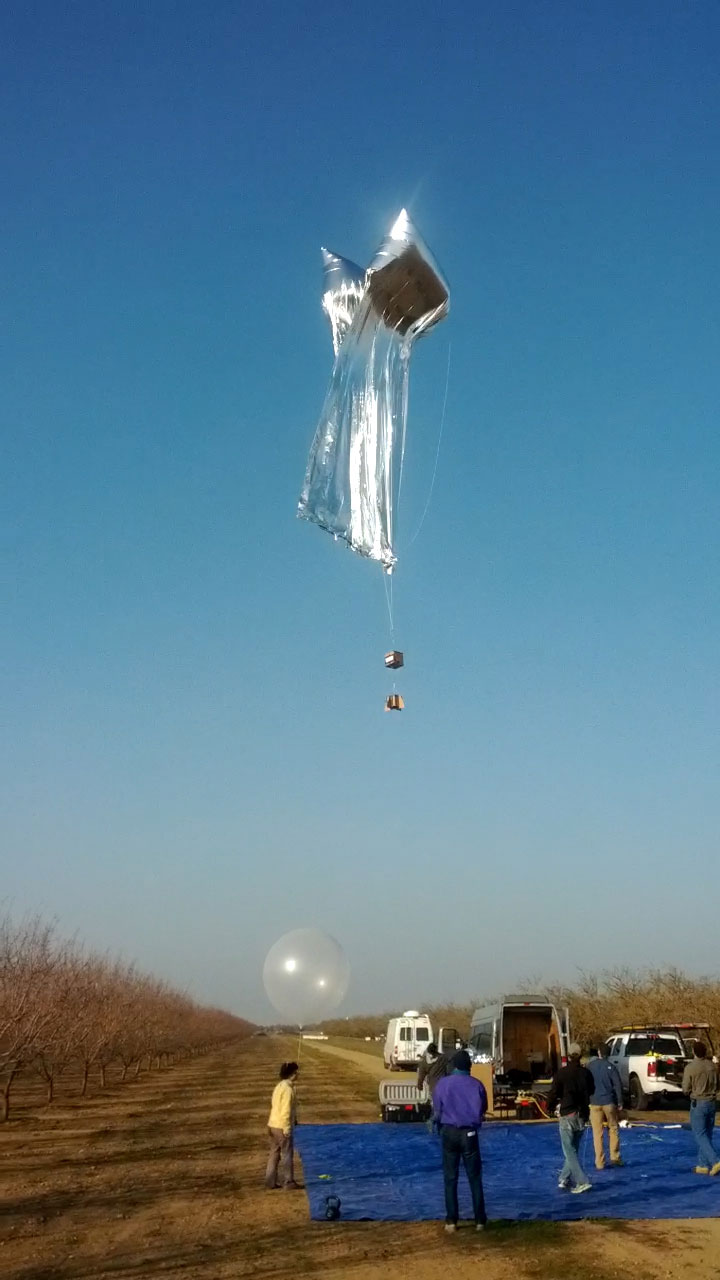
The early prototypes of Loon balloons were of all shapes and sizes, like this concept of a rectangular Mylar balloon (below), which was almost 4 floors in size. The concept was not used, but, of course, not because of the lack of brilliance!
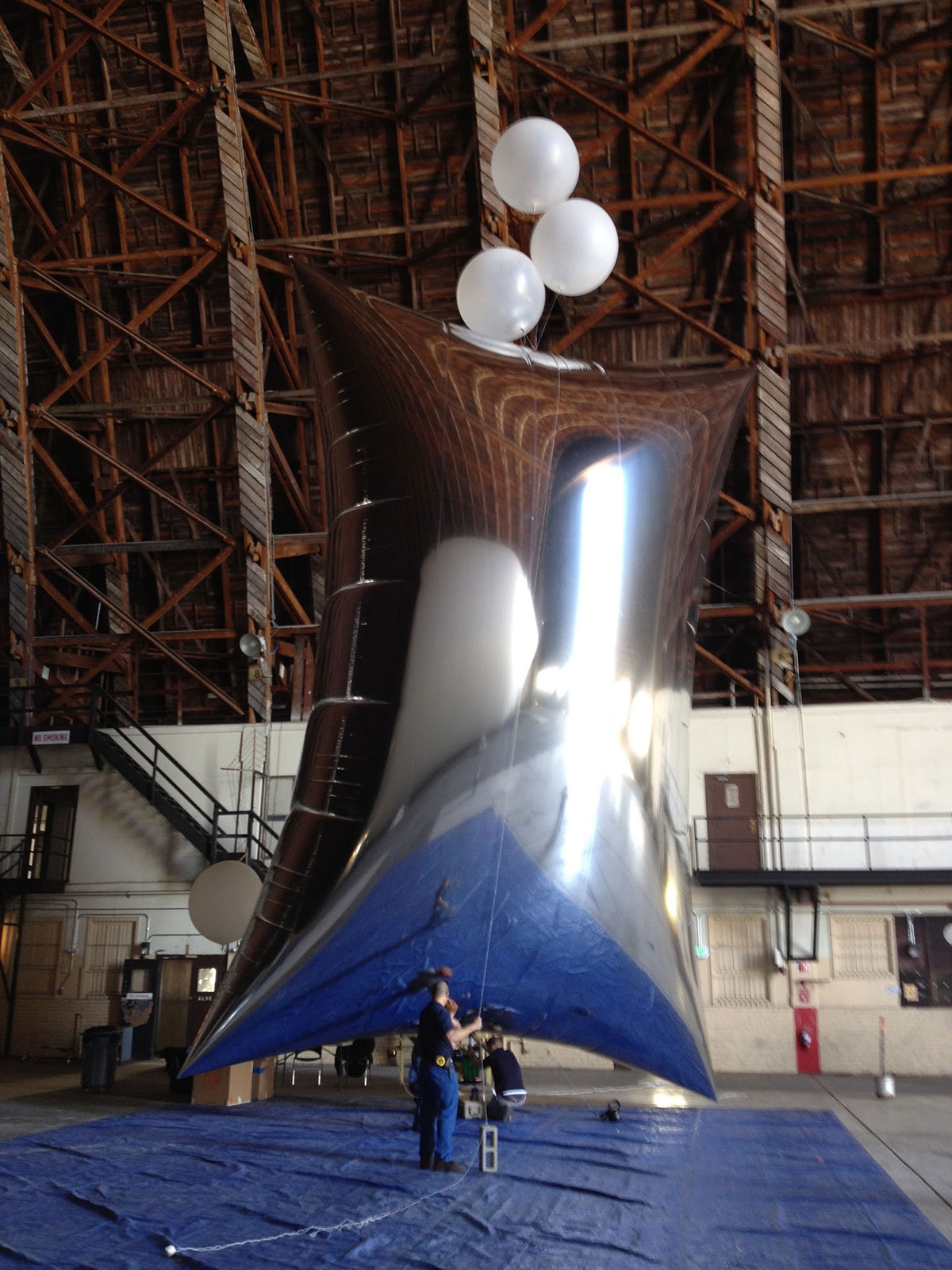
Before taking a balloon with new technologies into the real world, Loon had to test his ability to seal and fill the balls. Often balloons were inflated to the limit to burst under pressure.
This early prototype (below) in the shape of a round ball was called a "ball."

One of the balloons travels around the world in 22 days and counts the 500,000th kilometer of the way, starting the second round. This knowledge leads to significant improvements in models of wind forecasting, balloon trajectory, forecasting and navigation.

The Canterbury Sheep Breeder (New Zealand) was the first person to connect to the Internet using an Internet antenna attached to the roof of his house. The Loon project is open to the public, which helps explain some of the UFO sightings reported after testing around the world.

A lively winter morning in the New Zealand Canterbury Plains, where the Loon team is gearing up for launch.
In the days leading up to the New Zealand pilot test, the whole team woke up in the middle of the night, at dawn, and began preparing to launch the balloon when the wind was calmer. Despite fatigue, they received a reward in the form of very picturesque working conditions.
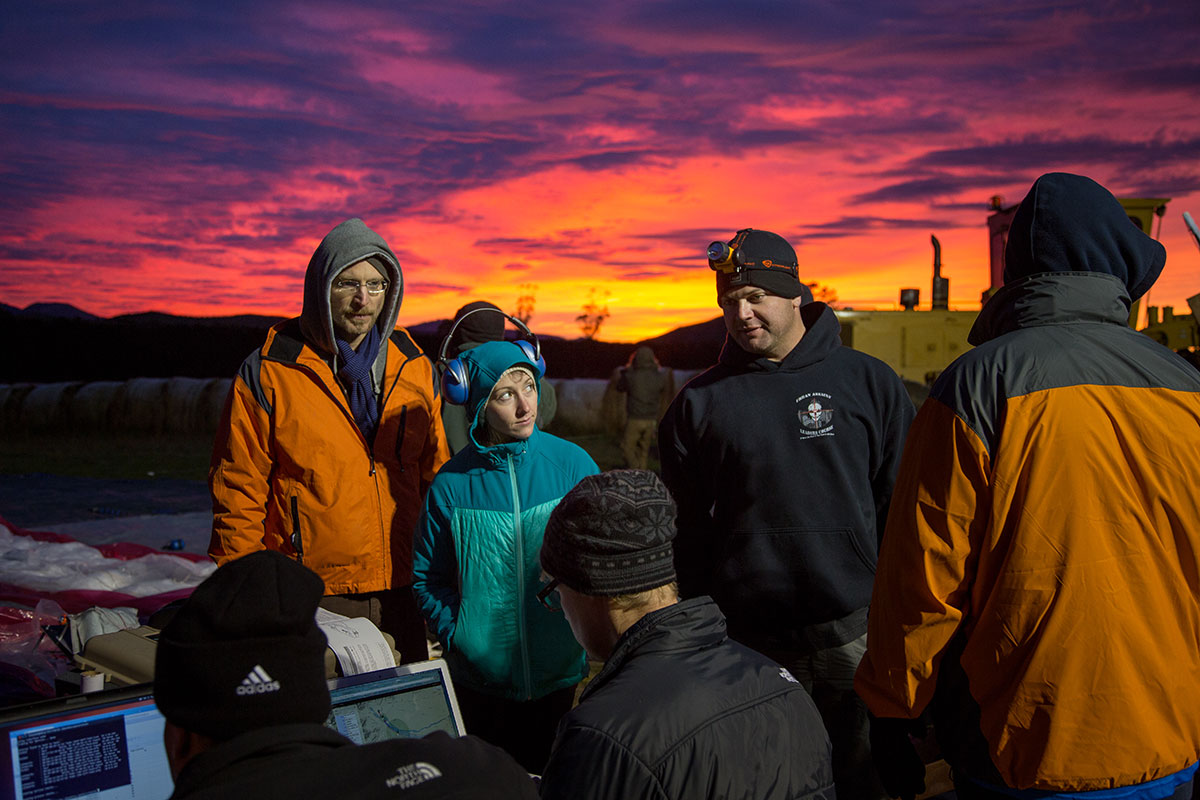
Launch day in New Zealand. A few hours after sunrise, over the Christchurch sky and the Canterbury plains on the south island, a flock of the first Loon test balls rose, with the first real user - a sheep farmer on the plains that Loon contacted.

The image of a Loon balloon flight en route to the stratosphere, with the New Zealand Southern Alps in the background, reflects a mission to connect people around the world.

The local school in Agua Fria, located in the rural neighborhood of Campo Mayor, Brazil, is first connected to the Internet using a balloon launched nearby. This marks the first successful LTE connection of the Loon project, 2014.

Rising rapidly over rural Agua Frias, Brazil, the Loon test balloon begins to swell before embarking on a mission to provide LTE connectivity with a local school.
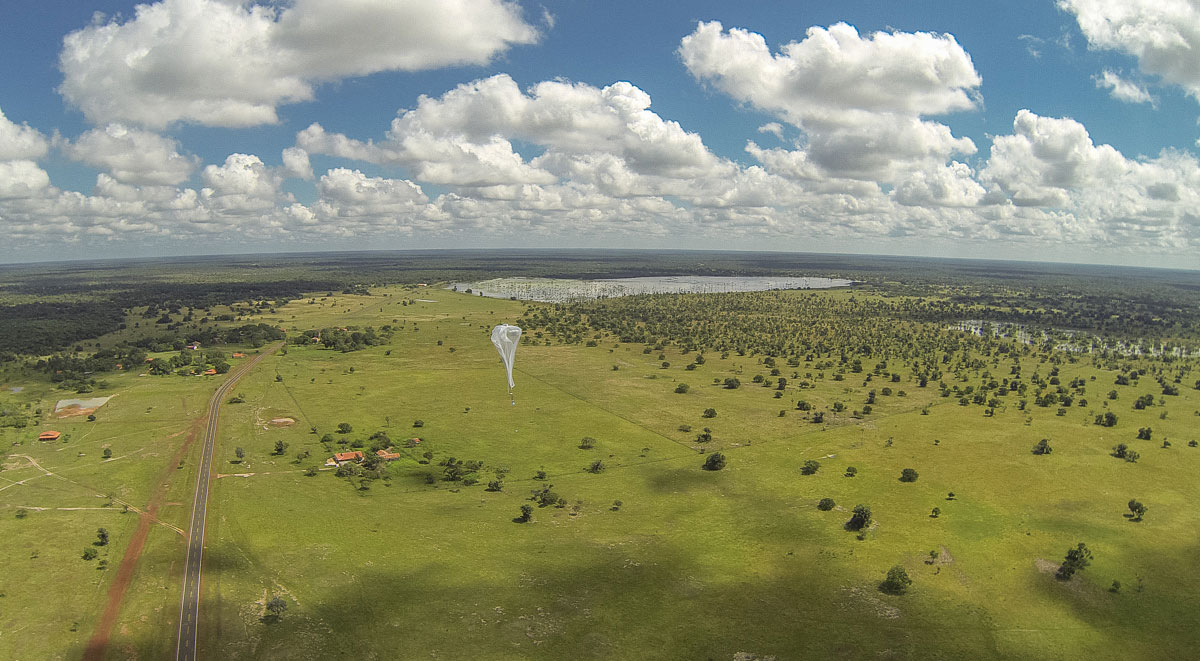
Before a breakthrough was made using algorithms that now help Loon navigate in the wind, engineers had to install antennas on trucks to chase balloons and be under them to test the service.

Before launching balloons, which could fly hundreds of days, a small team went to rural Brazil. The goal was to try connecting testers using Loon powered LTE technology for the first time. Loon successfully delivered the Internet to a local school during a geography lesson.
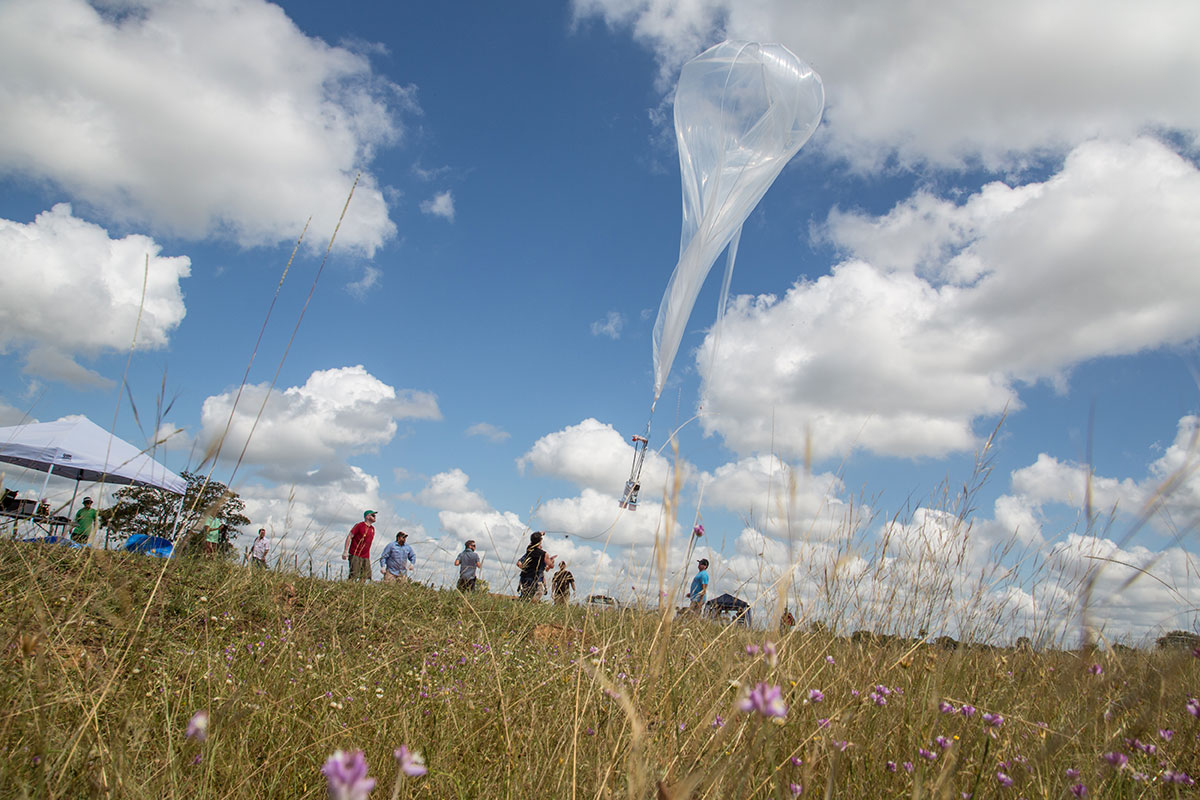
While the team was implementing LTE technology for a local school in Brazil, Loon engineers could not resist the opportunity to check the weather and wind in this new area. Loon launched 5 Ibis-class balloons (one of which is shown here) to experience everything that happens during a flight along the equator.

The entire infrastructure is based on LTE, the eNodeB component (the equivalent of a “base station” that communicates directly with phones) is transferred to a balloon. Initially, balloons communicated using WiFi (unlicensed ISM bands of 2.4 and 5.8 GHz), but then they switched to LTE.
Long-Term Evolution (LTE), also known as 4G, is a fast-growing global technology that is constantly evolving, providing unprecedented data transfer speeds, large capacity and a new level of user service.
The LTE specification provides peak downlink speeds of 300 Mbit / s, peak uplink speeds of 75 Mbps and QoS positions providing a transmission delay of less than 5 ms in the radio access network. LTE has the ability to control fast-moving mobile phones and supports multicast and broadcast streams. LTE supports scalable carrier bandwidths from 1.4 MHz to 20 MHz and supports both frequency division multiplexing (FDD) and time division multiplexing (TDD).
LTE overlaps the 3G network and therefore supports seamless LTE / 3G connectivity. 3G provides consistent broadband access when users go beyond LTE coverage and voice services throughout the network. 3G also provides global voice and data roaming for LTE devices.
Loon balloons as of 2014 covered over 3 million kilometers moving through the stratosphere, which is equivalent to four flights to the Moon and back. Millions of kilometers of test flights have helped to begin to more accurately predict the nature of the wind at different altitudes, which gives us the best opportunity to keep balloons where we need them.
One of the balloons launched in Latin America in 2016 was able to hold out in the air over Peru for 98 days, while it made almost 20,000 separate adjustments to the flight altitude.
It was originally planned that Google would acquire its own range of radio frequency spectrum so that Loon balloons could work independently of existing wireless networks. But Google has abandoned this and instead, balloons will be leased to cellular companies such as Safaricom, Airtel and Telkom Kenya.
Google is not the only company that seeks to provide mass access to the Internet. Facebook's communications lab is working on the creation of AQUILA, a wingspan-powered solar aircraft larger than the Boeing 737, which can continue to run for several months, hoping to do the same.
Sources:
spectrum.ieee.org/tech-talk/telecom/internet/internet-balloons-and-drones-look-to-rise-in-the-5g-era
https://loon.com/technology
medium.com/ iot-5g-extreme-ideas-lab / googles-ball-powered-high-speed-internet-now-in-kenya-be34c35f0f37
airsoc.com/articles/view/id/5cc5b2e8c4263cec6e67cd04/floating-cell-towers-are-the -next-step-for-5g
Thank you for staying with us. Do you like our articles? Want to see more interesting materials? Support us by placing an order or recommending it to your friends, a 30% discount for Habr users on a unique analogue of entry-level servers that we invented for you: The whole truth about VPS (KVM) E5-2650 v4 (6 Cores) 10GB DDR4 240GB SSD 1Gbps from $ 20 or how to divide the server? (options are available with RAID1 and RAID10, up to 24 cores and up to 40GB DDR4).
Dell R730xd 2 times cheaper? Only we have 2 x Intel TetraDeca-Core Xeon 2x E5-2697v3 2.6GHz 14C 64GB DDR4 4x960GB SSD 1Gbps 100 TV from $ 199 in the Netherlands! Dell R420 - 2x E5-2430 2.2Ghz 6C 128GB DDR3 2x960GB SSD 1Gbps 100TB - from $ 99! Read aboutHow to build the infrastructure of the building. class c using Dell R730xd E5-2650 v4 servers costing 9,000 euros for a penny?

Photo: Loon
As the world seeks to introduce 5G high-speed mobile networks on earth, some companies continue to focus on floating cell towers in the sky. During the final session of the sixth annual 5G Summit in Brooklyn on Thursday (April 25), Silicon Valley IT and telecommunications industry leaders discussed whether drones and balloons could finally begin to provide commercial mobile communications and Internet services from the air.
On the same day, Loon, a subsidiary of Alphabet Inc., was originally a division of the balloon research company Google X, which announced a strategic partnership with Softbank HAPSMobile to use solar-powered balloons and drones to expand mobile Internet coverage. and assisting in the implementation of 5G networks.
The possibilities are in our hands from the point of view of the real use of 5G in combination with a massive paradigm shift when it comes to UAS - drones, as well as satellitesSaid Volker Ziegler, CTO of Nokia Bell Labs.
No one expects Loon high-flying balloons and HAPSMobile drones to compete directly with 5G terrestrial networks in the near future. Until recently, it was not easy to develop a balloon or an unmanned platform / platform that was economical enough even for use in telecommunications, said Salvatore Candido, Alphabet's chief engineer and CTO at Loon. However, such high-flying platforms can help fill gaps when there is no coverage in rural or other underserved communities. Even rural areas of the United States may not meet current 5G plans.
A fleet of balloons and drones can also provide coverage on a temporary basis, for example, during major pre-planned events, such as the Super Bowl, or after natural disasters. Nokia previously partnered with Alphabet's Loon when it deployed its pilot balloon fleet to provide basic Internet services to 200,000 people in Puerto Rico after the island was destroyed in 2017 by Hurricane Maria, which hit the United States of America. . Nokia's LTE technology was installed on balloons as part of the broader coalition of AT&T and T-Mobile.
A billion people in the world do not have enough communication, whether temporarily because of a hurricane or simply because of where they live. I think that all these new technologies combined allow us to create networks that could reach a huge number of these people.-Salvatore Candido, Loon.
Loon has not yet begun implementing 5G equipment on its balloons, although a partnership with HAPSMobile Softbank suggests that someday it will be possible. However, the advent of 5G terrestrial networks can also make it easier for companies to deploy unmanned aerial vehicles or Internet balls. Nokia's Ziegler noted that 5G offers advantages over 4G LTE when implementing a relay / relay system that reflects a signal between groups of balloons or drones to expand the coverage area far beyond the ground station where the signal is coming from.
According to Giuseppe Loino, associate professor of electrical and computer engineering at the University of New York and director of Agile Robotics and Perception Lab, the presence of 5G network technology in terms of air traffic control can facilitate the tracking and control of a large group of unmanned aerial vehicles.
When the time comes, it will be important for telecom companies to create demand for high-speed mobile phones and Internet services by demonstrating what they can do for the public or customers, said Dallas Brooks, director of the Raspet Flight Research Laboratory at the University of Mississippi and Assistant Director of the ASSURE FAA Center of Excellence UAS. He invited the participants of the 5G Brooklyn Summit to collaborate with him and other universities participating in the research and testing program of the Federal Aviation Administration for the integration of drones in the US national airspace.
Loon may be one of the first to apply the solution with balloons, even if at the beginning they will not provide 5G services. The company's stratospheric balloons have already won their first commercial contract with Telkom Kenya to provide mobile services for nearly 50 million Kenyans. But Loon will certainly not be alone in trying to get such projects to work in the 5G era. “There is no shortage of people trying to create pseudo-satellites in the stratosphere,” Candido said.
A little about the technologies and principles of operation of balloon towers:
Communication with balloons flying in the stratosphere at an altitude of 20 km creates a number of unique engineering difficulties. To expand network connectivity in unreached and underserved areas around the world, Loon combines advances in materials science, atmosphere modeling, machine learning, communications systems and more.
Loon system
Loon took the most essential components of cell towers and redesigned them so that they were light and strong enough to be transported by balloon at an altitude of 20 km, at the edge of space. Loon balloons are designed and manufactured to withstand harsh conditions in the stratosphere, where the wind can blow more than 100 km / h and the temperature can drop to -90 ° C.

1. The balloon.
Each ball the size of a tennis court made of sheets of polyethylene is designed for more than 100 days of flight before landing on Earth in a controlled manner.
2. Flight equipment.
All flying equipment is highly energy efficient and runs on renewable energy sources. Solar panels provide power to the system during the day while charging the on-board battery, which allows you to work at night.
Flight equipment

1. Antennas.
Antennas transmit data from ground stations, over a balloon network and back to the user's LTE phone. The user does not need anything but a standard LTE phone to connect to a Loon balloon.
2. Solar panels.
Solar panels provide power to the equipment during the day and charge the on-board battery for nighttime use.
3. Flight capsule.
The flight capsule contains electronics, a small set of communication devices that include transceivers. In electronics, a transceiver is essentially a transmitter and a receiver in a single package to control the Loon system.

4. The parachute.
After the flight, the parachute will automatically deploy to safely return the ball to Earth.
Launch LOON
Custom-made, Autolaunchers systems are designed to safely and reliably scale Loon balloons. Side panels protect the balloon from the wind, as it is filled with lifting gas and set to run. The crane is directed downwind to smoothly release the Loon balloon into the stratosphere. Each tap is able to launch a new balloon every 30 minutes into the Loon network.
Movement behind the wind
Stratospheric flight:
Loon balloons fly about 20 km above the Earth’s surface in the stratosphere, well above planes, wildlife and weather.
Autonomous navigation:
From launch pads, Loon balloons can reach any country around the world. Predictive wind models and autonomous decision-making algorithms move each balloon up or down into the layer of wind blowing in the right direction, delivering the balloon to where it should be directed. The navigation system operates autonomously using algorithms and software, while operators provide continuous human control.
Intelligent Networks:
The Loon Balloon Group creates a network that communicates with people in a specific area in the same way that a group of towers on the earth form a ground network. The difference is that the Loon towers are constantly moving with the wind. The software constantly learns to improve the "choreography" of balloons, which improves the quality of the network. The entire network can function autonomously, effectively distributing connections between balloons and ground stations, taking into account the movement of balloons, obstacles and weather events.
Communication
Loon's large coverage area allows mobile operators to expand their coverage area where necessary. Loon transmits an operator signal from the connection points on the earth, radiates it through several balloons in the stratosphere, and then sends it back to the user's LTE device. The entire network can function autonomously, effectively distributing connections between balloons and ground stations, taking into account the movement of balloons, obstacles and weather events.

1. The wireless Internet signal is transmitted via the Loon ground station to the nearest balloon from a mobile operator located on the ground.

2. The signal is transmitted through a network of balloons Loon ball.

3. Standard LTE user phones connect to the mobile network via Loon balloons.
Landing and recovery
Loon maintains constant telemetry and team communication with each balloon, tracking location using GPS. When the balloon is ready for decommissioning, the lift gas holding the balloon in the air ends, the parachute automatically unfolds to control landing. Descent is coordinated with the local air traffic control service to safely land the balloon in a sparsely populated area. Then, ground recovery teams collect equipment for reuse and recycling.
Post-flight analysis

After recovery, balloons are laid out on a giant scanner in the Loon lab to check for microscopic holes and tears. This process paints a picture of how balloons react to conditions in the stratosphere. Performing this analysis allows you to draw the right conclusions when designing, which allows the team to develop balloons capable of flying for an increasingly long time.
Way to create
From the first days of balloon testing, design and manufacture of special starter equipment, and to providing communications for people after natural disasters, Loon has committed itself to address the challenge of expanding Internet access for remote communities around the world.
Testing ideas
The first tests were conducted back in 2011 using a meteorological balloon and base stations ready for the sale of radio frequencies - the first prototype. The next two years is a quick iteration process to prove that the Internet can work in a balloon.

Sometimes experiments did not go as planned. Here (below) a team of pioneering engineers are chasing an unsuccessfully launched ball in California's central rural valley. The balloon, which looked like a garbage bag, although it was pouted, was never left the ground.

Before designing and building ultra-high pressure balloons capable of withstanding hundreds of days of flight, the team worked diligently to understand the laws of physics in the stratosphere. Using balloons with zero pressure, as shown in the figure (below), the team observed how the gas expanded and contracted at extreme temperatures and pressures in order to understand their effect on the ability of balloons to stay afloat.

The early prototypes of Loon balloons were of all shapes and sizes, like this concept of a rectangular Mylar balloon (below), which was almost 4 floors in size. The concept was not used, but, of course, not because of the lack of brilliance!

Before taking a balloon with new technologies into the real world, Loon had to test his ability to seal and fill the balls. Often balloons were inflated to the limit to burst under pressure.
This early prototype (below) in the shape of a round ball was called a "ball."

500,000 kilometers covered in 2013
One of the balloons travels around the world in 22 days and counts the 500,000th kilometer of the way, starting the second round. This knowledge leads to significant improvements in models of wind forecasting, balloon trajectory, forecasting and navigation.

First WIFI connection
The Canterbury Sheep Breeder (New Zealand) was the first person to connect to the Internet using an Internet antenna attached to the roof of his house. The Loon project is open to the public, which helps explain some of the UFO sightings reported after testing around the world.

A lively winter morning in the New Zealand Canterbury Plains, where the Loon team is gearing up for launch.
In the days leading up to the New Zealand pilot test, the whole team woke up in the middle of the night, at dawn, and began preparing to launch the balloon when the wind was calmer. Despite fatigue, they received a reward in the form of very picturesque working conditions.

Launch day in New Zealand. A few hours after sunrise, over the Christchurch sky and the Canterbury plains on the south island, a flock of the first Loon test balls rose, with the first real user - a sheep farmer on the plains that Loon contacted.

The image of a Loon balloon flight en route to the stratosphere, with the New Zealand Southern Alps in the background, reflects a mission to connect people around the world.

First LTE
The local school in Agua Fria, located in the rural neighborhood of Campo Mayor, Brazil, is first connected to the Internet using a balloon launched nearby. This marks the first successful LTE connection of the Loon project, 2014.

Rising rapidly over rural Agua Frias, Brazil, the Loon test balloon begins to swell before embarking on a mission to provide LTE connectivity with a local school.

Before a breakthrough was made using algorithms that now help Loon navigate in the wind, engineers had to install antennas on trucks to chase balloons and be under them to test the service.

Before launching balloons, which could fly hundreds of days, a small team went to rural Brazil. The goal was to try connecting testers using Loon powered LTE technology for the first time. Loon successfully delivered the Internet to a local school during a geography lesson.

While the team was implementing LTE technology for a local school in Brazil, Loon engineers could not resist the opportunity to check the weather and wind in this new area. Loon launched 5 Ibis-class balloons (one of which is shown here) to experience everything that happens during a flight along the equator.

About long-term evolution - LTE / 4G
The entire infrastructure is based on LTE, the eNodeB component (the equivalent of a “base station” that communicates directly with phones) is transferred to a balloon. Initially, balloons communicated using WiFi (unlicensed ISM bands of 2.4 and 5.8 GHz), but then they switched to LTE.
Long-Term Evolution (LTE), also known as 4G, is a fast-growing global technology that is constantly evolving, providing unprecedented data transfer speeds, large capacity and a new level of user service.
The LTE specification provides peak downlink speeds of 300 Mbit / s, peak uplink speeds of 75 Mbps and QoS positions providing a transmission delay of less than 5 ms in the radio access network. LTE has the ability to control fast-moving mobile phones and supports multicast and broadcast streams. LTE supports scalable carrier bandwidths from 1.4 MHz to 20 MHz and supports both frequency division multiplexing (FDD) and time division multiplexing (TDD).
LTE overlaps the 3G network and therefore supports seamless LTE / 3G connectivity. 3G provides consistent broadband access when users go beyond LTE coverage and voice services throughout the network. 3G also provides global voice and data roaming for LTE devices.
3 million kilometers
Loon balloons as of 2014 covered over 3 million kilometers moving through the stratosphere, which is equivalent to four flights to the Moon and back. Millions of kilometers of test flights have helped to begin to more accurately predict the nature of the wind at different altitudes, which gives us the best opportunity to keep balloons where we need them.
One of the balloons launched in Latin America in 2016 was able to hold out in the air over Peru for 98 days, while it made almost 20,000 separate adjustments to the flight altitude.
It was originally planned that Google would acquire its own range of radio frequency spectrum so that Loon balloons could work independently of existing wireless networks. But Google has abandoned this and instead, balloons will be leased to cellular companies such as Safaricom, Airtel and Telkom Kenya.
Other companies:
Google is not the only company that seeks to provide mass access to the Internet. Facebook's communications lab is working on the creation of AQUILA, a wingspan-powered solar aircraft larger than the Boeing 737, which can continue to run for several months, hoping to do the same.
Sources:
spectrum.ieee.org/tech-talk/telecom/internet/internet-balloons-and-drones-look-to-rise-in-the-5g-era
https://loon.com/technology
medium.com/ iot-5g-extreme-ideas-lab / googles-ball-powered-high-speed-internet-now-in-kenya-be34c35f0f37
airsoc.com/articles/view/id/5cc5b2e8c4263cec6e67cd04/floating-cell-towers-are-the -next-step-for-5g
Thank you for staying with us. Do you like our articles? Want to see more interesting materials? Support us by placing an order or recommending it to your friends, a 30% discount for Habr users on a unique analogue of entry-level servers that we invented for you: The whole truth about VPS (KVM) E5-2650 v4 (6 Cores) 10GB DDR4 240GB SSD 1Gbps from $ 20 or how to divide the server? (options are available with RAID1 and RAID10, up to 24 cores and up to 40GB DDR4).
Dell R730xd 2 times cheaper? Only we have 2 x Intel TetraDeca-Core Xeon 2x E5-2697v3 2.6GHz 14C 64GB DDR4 4x960GB SSD 1Gbps 100 TV from $ 199 in the Netherlands! Dell R420 - 2x E5-2430 2.2Ghz 6C 128GB DDR3 2x960GB SSD 1Gbps 100TB - from $ 99! Read aboutHow to build the infrastructure of the building. class c using Dell R730xd E5-2650 v4 servers costing 9,000 euros for a penny?
